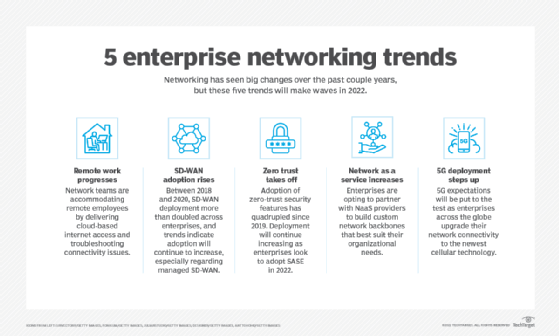
Getty Images
5 trends in enterprise networking that defined 2021
In 2020, enterprises shifted to remote work due to the pandemic. The trend continued in 2021, along with four other networking trends that defined the year and will extend into 2022.
Enterprise networking is going through major changes.
Traditional MPLS networks are giving way to software-defined WAN (SD-WAN) and hybrid connectivity that facilitates cloud-bound internet traffic. Remote work has become normalized for many companies after 18 months of COVID-19 pandemic-related office closures and work-from-home mandates. And network security has come into sharp relief. But how can network teams properly secure and maintain their networks as remote workers, internet access and BYOD all become more common?
To complement the year's end, let's look back on some of the major trends in networking that stood out in 2021. These trends -- which include remote work, SD-WAN and zero-trust security (ZTS) -- are likely to continue to develop into the coming year.
1. Remote work is changing the face of corporate networks
It's no longer possible to sideline remote workers when considering a network.
In 2020, office life experienced a massive disruption as companies sent many workers home because of the pandemic. As remote work continued into 2021, many enterprises cemented new workplace flexibility policies.
Network teams accommodated the initial shift to remote work by distributing work devices, increasing data center bandwidth and scaling up VPN gateways within the first few weeks of lockdown mandates. Now, with a slew of companies considering full-time remote or hybrid work schedules long term, network teams must prioritize the remote end-user experience.
Companies may look to cloud-based internet security providers to secure remote end users. Many network teams have shifted their job responsibilities to help employees upgrade their residential broadband plans and troubleshoot Wi-Fi performance issues. Some high-priority workers have even been issued small at-home SD-WAN devices.
Companies that embrace remote or hybrid work may also revisit -- and potentially downsize -- their real estate footprints. A network manager at a financial services company said their organization plans to reduce the number of corporate offices from 200 to less than 20 by 2024. These major reductions will have implications on planning new network technology deployments and could affect total network spend. While fewer people may go to certain offices, reducing bandwidth isn't necessarily the right move, due to deeply entrenched video conferencing habits that eat up a lot of bandwidth.

2. SD-WAN matures into mainstream adoption
SD-WAN adoption has moved from the early adopter phase to the larger enterprise audience.
In a recent survey of SD-WAN adoption among enterprises, TeleGeography found that SD-WAN installation rose from 18% in 2018 to 43% in 2020. Few survey respondents indicated a decision to avoid adopting SD-WAN at all. TeleGeography expects strong adoption growth to continue for the next few years.
The nature of the SD-WAN market has changed as it matures. In the early days of SD-WAN, a DIY attitude prevailed. Enterprises that took on SD-WAN often worked directly with an SD-WAN vendor rather than going through a managed service. However, the portion of enterprises that worked directly with an SD-WAN vendor decreased from 46% in 2018 to 38% in 2020, while the percentage sourcing from a carrier or third-party provider rose in the same period, according to TeleGeography survey data.
SD-WAN has become a core offering in the enterprise WAN portfolio for many network service providers. A glut of M&A activity has also occurred among SD-WAN suppliers and legacy network hardware and equipment vendors. The result: Mainstream enterprise customers, who may not have full engineering teams to manage SD-WAN rollouts, have more managed SD-WAN options.
In 2017, the market comprised only 11 managed SD-WAN offerings, compared to the 80 managed SD-WAN providers TeleGeography profiled in 2021.
3. Never trust, always verify
With more end users accessing corporate tools over their home internet and increased corporate traffic traveling over the internet toward cloud applications, enterprises need new network security paradigms. In contrast to traditional perimeter-based security, a "never trust, always verify" security philosophy, often called zero-trust security, has gained popularity among companies looking to secure networks with greater security vulnerabilities than ever.
There's been a significant shift in interest and knowledge around ZTS in recent years. According to TeleGeography's "WAN Manager Survey," the percentage of enterprise respondents who have implemented some element of ZTS has risen from just 8% in 2019 to 35% in 2021. Among that group, multifactor authentication and single sign-on were the most common ZTS features implemented.
Secure Access Service Edge (SASE), a term for a network architecture framework that synthesizes SD-WAN and cloud-based ZTS, has quickly been adopted by the network vendor community. This term is currently more aspirational than descriptive of options available in the current market. But, in the next year or so, we'll see if vendor offerings mature to meet the idea of SASE and if the large enterprise market is interested in putting all its network security eggs in one basket.
4. Build your own backbone
To replace managed MPLS connectivity, some large enterprises with complex data needs and hybrid networks are starting to engineer their own backbones between their data centers.
As one WAN manager said in a recent interview: "Anything the carriers could do for us, we can now do ourselves cheaper."
Network-as-a-service providers, like Equinix, Megaport and PacketFabric, are facilitating these NaaS models. Enterprises can quickly provision and spin up transport between data centers, often with more flexibility in billing models. Enterprises can also upgrade bandwidth with private lines between key locations versus managed MPLS, which is pricier by bandwidth.
Companies moving workspaces to the cloud and using internet connectivity need a stronger understanding of their underlay geography. Data center proximity, number of carriers present, cloud provider connectivity and price will all come into play when selecting data center locations and deciding on a private backbone.
5. 5G goes live for enterprises
Carriers ramped up 5G deployments in 2021. According to TeleGeography data, 5G went from constituting 0.4% of global wireless offerings in 2018 to almost 5% in 2021. The total number of 5G networks around the globe is expected to reach 220 by the end of 2021.
While 5G has long been hyped for the potential of its higher download rates and ability to prioritize traffic, those use cases will be put to the test as availability expands into major metro areas.
One key 5G use case will likely be as a secondary or tertiary line for remote areas with limited diversity in connectivity. Earlier implementations can be expected as a campus LAN technology that supports network slicing. For many, it may be a fuller version of the usual mobile use case for quickly spinning up sites with temporary connectivity.
The more ambitious dreams of 5G await more mature network deployments and the development of IoT devices to take advantage of its more intelligent uses.
For now, availability still needs to expand for 5G to be of much use as a WAN technology, and prices are still high.
What can we expect in 2022?
Enterprises can expect to see developments in the following areas throughout 2022:
- Work-from-anywhere flexibility will expand with an increased focus on remote user experience.
- Zero-trust network security strategies will see increased uptake by network managers looking to secure their network against next-generation threats.
- SD-WAN deployments will mature with carrier managed SD-WAN services gaining traction.
- Some companies will take on engineering their own private backbones between data centers, using NaaS capabilities.
- 5G deployments greatly matured in 2021, and enterprise adoption will likely become more widespread.








